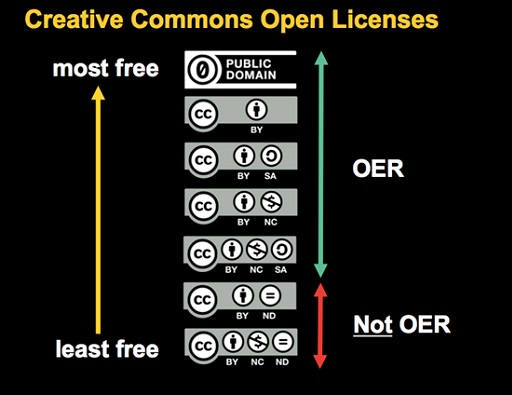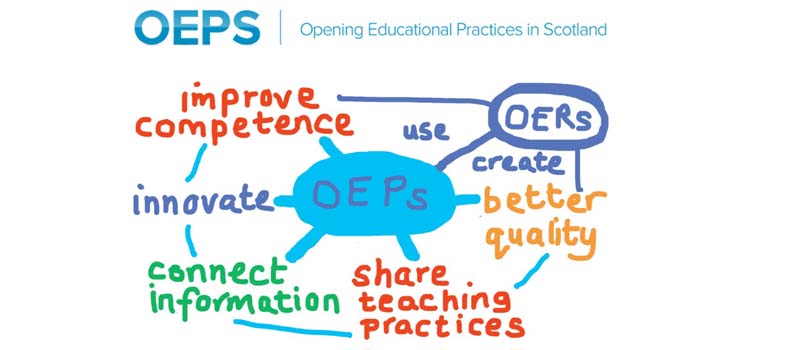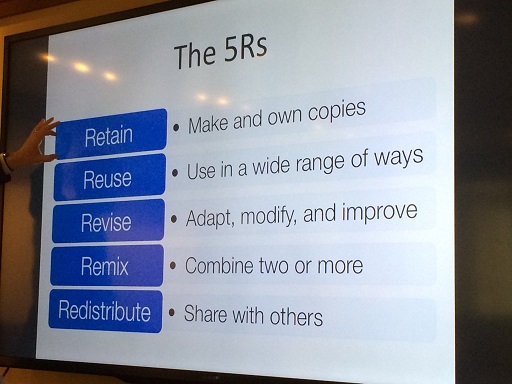2.2 The meaning of ‘open’ in open licensing
Before looking at some of the reasons you might want to use open educational resources (OERs) or adopt more ‘open’ practices, let’s pause briefly and take another closer look at the concept of ‘open’ within the context of (re)using OER. Copyright is primarily concerned with what you cannot do with material and restrictions on its use, whereas an open licence offers the possibility of reuse and remixing without having to seek the creator’s permission or needing to pay a fee for using the material.
Section 1 of the course revealed the variety of characteristics usually associated with ‘openness’ and how people define ‘open’ in different ways. Moreover, in addition to the diversity of contexts that could be described as ‘open’ there are not just open or closed practices, but many different shades of open behaviours or practice: what is described as a ‘continuum of openness’ [Tip: hold Ctrl and click a link to open it in a new tab. (Hide tip)] .
Section 1.3 introduced one definition that is commonly referred to when exploring the idea of ‘openness’ within the context of the use and creation of OER: the ‘5 Rs’ that David Wiley, a well-known advocate of open education, has developed (see Figure 2.1). The 5 Rs highlight the benefits and freedoms, rather than restrictions in place, on a resource with an open licence:
- Retain – the right to make, own, and control copies of the content.
- Reuse – the right to use the content in a wide range of ways (e.g. in a class, in a study group, on a website, in a video).
- Revise – the right to adapt, adjust, modify, or alter the content itself (e.g. translate the content into another language).
- Remix – the right to combine the original or revised content with other open content to create something new (e.g. incorporate the content into a mashup).
- Redistribute – the right to share copies of the original content, your revisions, or your remixes with others (e.g. give a copy of the content to a friend).
According to Wiley and this ‘rights’-based framework for understanding what an open licence enables you to do, if a resource fulfils all these criteria and therefore is explicit in giving you the ‘right’ to remix, retain, reuse, revise and redistribute a resource, then it can be described as an open educational resource (OER). By and large, open licences are used to convey relevant information associated with the 5Rs: this is because open licences such as Creative Commons act as a shorthand to giving permission for reuse, are widely used and easily understood.
As can be inferred from some of the Rs listed above, openness in this context also involves changes to the way you might approach or create material, or collaborate with others. For example, with an OER you are able to circulate or use copies of material without seeking the author’s permission to do so. You can also develop new material based on existing open content under the permissions granted by the original author. In both instances, because an OER should clearly state the reuse criteria, you can save time and money, as you do not need to wait for author permission to reuse a resource and you don’t need to spend time creating your own resource from scratch when someone else has already created something you can reuse or modify for your own purposes.
Creating new resources with OER might enable collaborative experimentation with colleagues, highlight the benefit of sharing resources and good practice, enable iterative improvement to resources, or even highlight social justice by opening up new opportunities for those not currently engaged in, or distanced from, formal education. One example of using open resources to engage with the wider community is Strathclyde University’s widening participation strategy, which ‘aims to remove barriers for under-represented groups to get to university’. More on how this was developed is discussed on the OEPS hub.
However, it's not just about your ‘right’ to do certain things with material that is openly licensed. Implicit in the idea of the 5Rs and in order for the ‘right’ to remix, reuse, redistribute, revise and retain to be possible, you also need to enable others to do the same (so they have the same ‘rights’ as you) by sharing back your remixed material or original content (in other words, facilitating the ‘virtuous circle’ noted earlier in Section 1.4: The practice of open educational resources).
One component of this is the licence. As described in Section 1.5 there are different types of licences giving different types of permissions for reuse. These different licences can be understood as a ‘continuum of openness’, as some are more liberal in their reuse permissions than others. Figure 2.2 below shows licences placed along a scale of ‘least free’ to ‘most free’ and correspondingly ‘not OER’ to ‘OER’ (note ‘free’ is understood as ‘libre’ within this context, see Section 1.2 for further explanation.)
If you need reminding of the licence types, check out Creative Commons.

As you can see from Figure 2.2, there are some Creative Commons licensed resources that are not considered to be OER and are described as the ‘least free’ of the open licences (the CC-BY-ND and CC-BY-SA-NC licences). This is because these licences include ‘ND’ or the ‘no-derivatives’ instruction. In other words, when using the resource it can only be used ‘as is’ and not modified in any way. This prohibits any adjustment, changes or building on the resource, either so that it reflects better your own context(s) or to combine it with other OER or materials you have created. Therefore, the ND licence fails to fulfil the ‘revise’ and ‘remix’ criteria of Wiley’s 5Rs.
There are arguments for and against using different types of Creative Commons licences, in particular the NC or ‘non-commercial’ licence. In the instance of NC-licensed materials, some people argue that prohibiting commercial use of resources can stifle innovation. US educator and co-author of the open textbook Introductory Statistics, Barbara Illowsky, explains why their textbook is CC-BY:
I wanted to talk about commercial aspects... So one of the interesting comments we have, is how could you not put the NC on your licencse, how could you agree to a CC-BY because somebody else can take your work and make money. That’s true, but if we didn’t put that BY on there, there wouldn’t be other innovations. So, for example, another college... their bookstore wouldn’t be able to sell the book because they earn a profit on the hard copy of it. WebAssign... Collaborative Statistics was the first Open Ed Resource that they hooked up with to do a homework system with. Before they were working only with major publishers. But when I was starting to present at national conferences, and faculty said I love this book but I would never adopt it because I don’t want to go back to grading homework... The trade-off of a student spending $200 for a book that comes with a homework grading system, or me having to grade homework, they are going to buy the book.
So I approached WebAssign – it’s a fabulous company – but it does cost the students $25. So I tell the students, I recommend it but you don’t have to buy it. If you want to turn in the hard copy paper with your problems worked out to me you can, but I think that the WebAssign has a learning system that goes along with it, they have the videos integrated, they have the books integrated... if you get stuck on a homework problem, it takes you back to the book if you want [etc.]... So I think this is a valuable learning tool, not just making my life easier for grading … now I’ve only had two students who started out turning in a hard copy paper and they eventually ended up buying it. So that’s a company that is doing innovation, but if I had the NC license on it, they wouldn’t.
A more in-depth exploration of the NC licence is also available here.
Many national or international organisations that support the use of openly licensed materials argue for the use of the CC-BY licence; for example the Wellcome Trust, as this type of licence gives ‘much greater use – and therefore impact – of the research we fund and the content we produce.’
Later in the course you will look at developing your own resources and return to look at David Wiley’s 5Rs to help you understand what you need to do to enable others to easily find, use, remix and adapt resources you choose to share.
Activity 2A
This section has explored shades of openness within educational resources that are described as ‘open’ or OER. However, the idea of ‘open’ is also applicable to other contexts, including everyday practice.
Think about your own context and use your reflective log to write down:
- Examples of practices that could be considered ‘open’.
- Instances where it might not be appropriate to be open.
2.1 Introduction

